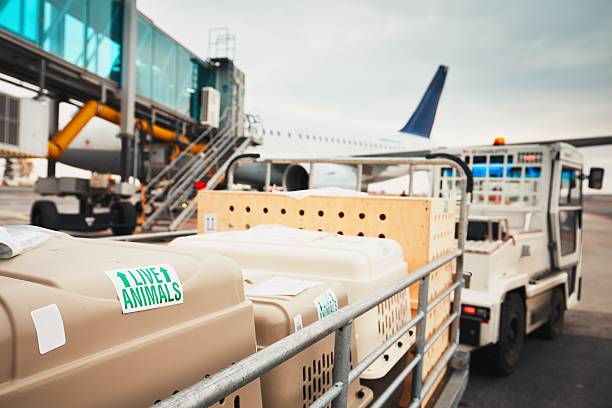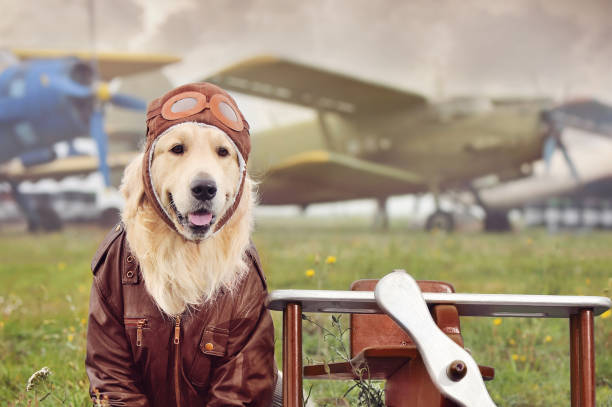What does it mean to fly with your pet as Cargo and why would you do it?
If you do not have the option to fly with your pet as Excess Baggage or In-Cabin, they must fly as Cargo.
A pet flying as Cargo is not attached to your airline ticket. You do not have to be on the same flight as Fido or Fluffy, and even if you would like to be on the same flight, it is not necessarily guaranteed.
Some flights (usually lengthy overseas flights) will not allow In-Cabin pets, and many pets are too large to fly In-Cabin.
Flying Cargo is usually the most expensive way for pets to fly, around $1,000 and up. Not all airlines are the same, so be sure to check pet travel options before you decide which airline to book if you have not yet done so.
Pets flying Cargo overseas usually require the same paperwork as those flying Excess Baggage, although some countries will also require a pet import permit. The fees are much greater than other shipping methods. Some of the additional fees may include:
- Manifest Cargo fee
- Import permit fee
- Border clearance charge
- Housing fee (until you are able to pick up your pet)
- Custom kennel fee (for extra large dogs)
- Ground transportation (Pet Taxi) fee
- Quarantine fee, if required by the country the destination country
As you can see from the above list, cost can add up quickly to ship a pet cargo, especially if it is an extra large dog such as a Great Dane.
As we discussed in How To Fly Your Pet Overseas, airlines have strict crate regulations. There must be plenty of room for pets to sit, stand and lay down without touching the top of the crate. For extra large dogs, this can be a problem. You may have to have a custom crate made or purchase an extender (that still meets TSA requirements). It is not unheard of for a custom crate for a large dog to cost $1,000. In addition to the significant crate costs, you get the added bonus of the possibility of that giant crate not fitting through the door to the belly of the plane. When this happens, you have to find a larger aircraft for your furry friend, which often means traveling to a large airport because smaller airports usually service smaller planes. If you are not able to drive Fido yourself, this is where the ground transportation cost may come in. We ran into this problem on one of our flights with our dog, and he was only a medium dog flying in a large crate. We had to drive a rental car to another state with a larger aircraft which gave us the added costs of a rental car and a night in a hotel before flying.
Airlines have special departments for pets being shipped Cargo, and as each airline is different and regulations are constantly changing, you will need to call your airline (or multiple airlines if you have not yet chosen one) to find out their costs and restrictions. My motto is: call, call again, book, confirm and re-confirm, as I am not always told the same thing when I call airlines about pet travel. Some additional things to keep in mind:
- Not all breeds are allowed in all countries. On top of this, many airlines will not fly certain breeds, (even if they are not banned in the country) to include snub-nosed pets due to their breathing difficulties or those breeds characterized as aggressive.
- Airlines often have a minimum age for pets before they are allowed to be shipped. Since life spans vary depending on the breed, there is no maximum age. Instead, your veterinarian will determine if your elderly pet is healthy enough to fly.
- If your pet is not in good health for any reason, it may not be allowed to fly. Make an appointment with your veterinarian to see if your pet will be given the go-ahead for the trip. Do this early (see How To Fly Your Pet Overseas for more details).
- Your timeline is important. Your pet must have a microchip compatible with the country they are flying into (for example, the microchips we had implanted in our pets in America were not compatible with those in Europe so they each had to have a second microchip). AFTER the microchip is implanted, they must have a rabies vaccine. This must be done at least thirty days before flying. The final health assessment for your pet, in which you will be given their health certificate allowing them to fly, must be done no more than ten days before arrival at the destination country. After you get the health certificate, you must then get the USDA approval to fly.
- Pay attention to the length of the trip. Some airlines will not allow your pet to be on a trip that takes over a certain number of hours. If this applies to you, you will either have to pay for ground transportation to a larger airport that will shorten their flight time or drive them there yourself.
- Where your pet will stay. If your pet leaves before you do, they will have to have somewhere to stay until your arrival. If they leave after you do, you will have to have a trusted friend or family member house them and then jump through the hoops to get them on the flight.
- The day of travel, you will drop off your four-legged friend to Cargo shipping, not the main terminal. You will also pick them up at Cargo on the other end as well. If you are flying the same day, you will need to allow at least an extra hour prior to your check-in.

This is obviously a complicated process and will require a lot of planning. As early as possible, start the process by seeing your veterinarian, as he/she will be able to find out the requirements for the country you are flying into, and walk you through the timeline and paperwork you will need. If the transport of the animal is going to be too much for you during an already stressful time of relocating overseas, there is another option: hire professional pet relocators. Your veterinarian and your airline will have recommendations. You will still have plenty to do to prepare your pet, but the pet movers will walk you through it step by step. Of course, by adding a middleman, you are also adding an extra cost to an already expensive journey, but our fur babies are part of the family, and we take care of our families. Check with your airline before you hire pet relocators as some airlines have requirements on which pet movers they will work with.
There is a lot to do and worry about when flying your pets overseas. We have flown overseas with babies, toddlers, young children, teenagers and our “furry beasts.” For me, flying with the pets was far more stressful, every single time. Be organized, start early and plan your timeline accordingly. It may not be easy, but it’s doable, and it is worth it.

